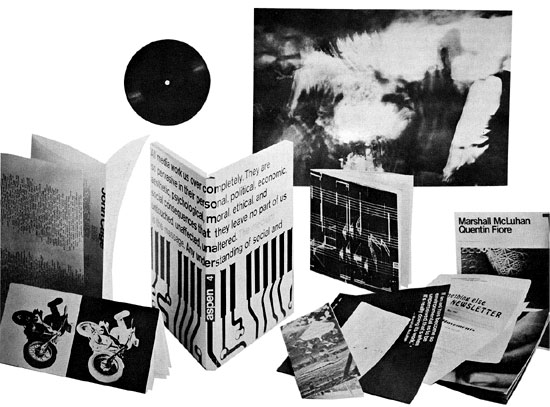| << UbuWeb |
| Aspen |
|
|
| August 1967 advertisement |
 |
||
 |
|
The message is Aspen. Aspen Magazine is a McLuhanism. Being three-dimensional, and therefore not limited to the printed word it stimulates touch and hearing as well as sight like no twodimensional magazine has ever done before. Until now, every magazine was a bunch of pages stapled together. It arrived in your mailbox folded, mutilated and spindled—usually with more ads than editorial. But why? asked our editors. Why couldn't a magazine come in a box? Why couldn't each article be a separate booklet, in the shape, color and paper most appropriate to the subject? Why shouldn't an article exploring jazz be accompanied by an LP record illustrating in sound our words in print? Aspen Magazine is the answer. Our editors, no longer limited by the restrictions of a bound magazine have let their imaginations soar. They are thinking in three dimensions. And there is no end to the exciting ideas. Take our current McLuhan issue, designed by Quentin Fiore, co-author with McLuhan of the new best-seliing paperback, "The Medium is the Massage." Our medium will massage you with McLuhan messages about the tribal man (a psychedelic poster of "The Tribal Stomp" at the Avalon Ballroom, San Francisco); the multisensuous man ("The Braille Trail," a self-guiding nature trail for the blind, both seeing and non- |
seeing); the electronic man ("The Electronics of Music," with a record of electronic music); the information man (excerpts from a diary of John Cage); the anti-environment man ("Psycles," the hippy and outlaw motorcyclists ), plus a press proof of 32 pages from the new McLuhan-Fiore book. Our advertisers are rising to the challenge too, with special booklets and newsletters—"Real News is Bad News. Advertising Is All Good News." Each issue of Aspen is the work of different top designers; each issue is a complete surprise. You never know what will pop out. Andy Warhol and David Dalton put our last issue in a Fab box. Our fifth issue, devoted to Far Eastern Thought, will be designed in authentic Oriental manner complete with scrolls and poem card decks, and maybe even edible rice paper. It will be the issue you hang all over the house. But Aspen is not only a delight to the eye, it's a feast for the intellect with content as unexpected and rewarding as the format. Aspen's ambition is to cover everything that enhances life and anything that can be described as a civilized pleasure of modern living—art, architecture, music (always with a record), dance, gourmet dining, nature and conservation, concrete poetry, underground movies, avant-garde theater, iconoclastic people. Why do we call it Aspen? Because we're using the cultural spa of the Rockies as a point of view, a state of mind, a symbol of the free-wheeling life (much as The New Yorker uses New York). |
Aspen is published quarterly. A single copy is $4, but a subscription brings you six issues for $16. That's $8 below the single-copy price of $24. It's not cheap, but then, it's not cheap to produce. And look what you get. At the least, a conversation piece. At the most, a phenomenal collector's item that will bring you an abundance of pleasure and edification.
|
|
from Evergreen Review no. 48, August 1967 |
|
|
|
|
|
|
|